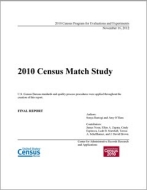
An official website of the United States government
Here’s how you know
Official websites use .gov
A .gov website belongs to an official government organization in the United States.
Secure .gov websites use HTTPS
A lock (
) or https:// means you’ve safely connected to the .gov website. Share sensitive information only on official, secure websites.
-
//
- Census.gov /
- 2010 Decennial Census Program Management /
- 2010 Census Program for Evaluations and Experiments (CPEX) /
- 2010 Census Match Study
2010 Census Match Study
2010 Census Match Study
Executive Summary
To reduce costs, many countries use administrative data to assist in censuses or as a replacement to traditional censuses (Farber and Leggieri 2002, Ralphs and Tutton 2011). Currently, administrative data are utilized in numerous, critical U.S. Census Bureau programs for population, economic, income and poverty, and health insurance estimates, but administrative data have not yet been extensively used to assist in decennial census operations. The Census Bureau is researching ways in which to use administrative data in decennial census operations to reduce costs. This study, building and expanding on previous research that utilized Census 2000 results, provides a foundation for decennial census operational research on administrative records by assessing the quality and coverage of administrative data relative to the 2010 Census.
In the United States, decennial censuses determine apportionment of state representation to Congress, are used in state redistricting, and are used to distribute billions of federal dollars (Reamer 2010). While households are required by law to participate in the decennial census, there are many households that do not respond to initial contact attempts. This requires the Census Bureau to send enumerators door to door to collect data from non-responding households in decennial census operations called Nonresponse Followup Operations.2 This effort is expensive for the Census Bureau and was estimated to cost around 1.4 billion dollars in Census 2000 of a total census budget of six billion dollars (Farber and Leggieri 2002, Walker et al. 2012). The estimated cost of these operations in the 2010 Census was about two billion dollars (Walker et al. 2012). Administrative records may be able to assist with expensive operations such as Nonresponse Followup Operations, which would save the government and taxpayers a substantial amount of money.
Census Bureau staff conducted research on the use of federal administrative data utilizing Census 2000 results. The Statistical Administrative Records System (StARS) was developed from select federal data sources in 1999. Decennial census research using these data included address and person count comparisons relative to Census 2000 (Farber and Leggieri 2002). StARS 1999 was also utilized in a field test that simulated a census in several counties during Census 2000 (Berning 2003, Bye and Judson 2004).
The 2010 Census Match Study builds on this research by evaluating the federal data sources used in StARS, additional federal data sources, and commercial data. This report is also distinctive from past research in that it matches addresses and persons in administrative records to the 2010 Census to evaluate the quality and coverage of administrative data. The matching is conducted using unique address and person identifiers called master address file identification numbers and protected identification keys assigned by the Person Identification Validation System to addresses and persons in the 2010 Census and administrative records. Using count and match ratios, this study evaluates the administrative data and the 2010 Census at different levels of geography and by factors such as Hispanic origin, race, and mode of data collection. This report also evaluates the quality and coverage of Hispanic origin, race, sex, and age response data in administrative records relative to the 2010 Census.
Others in Series
Publication
Publication
Publication
Share
Related Information
Some content on this site is available in several different electronic formats. Some of the files may require a plug-in or additional software to view.
 Yes
Yes
 No
NoComments or suggestions?


Top

